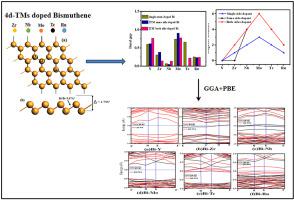Physica E: Low-dimensional Systems and Nanostructures ( IF 2.9 ) Pub Date : 2020-10-09 , DOI: 10.1016/j.physe.2020.114464 Isa khan Muhammad , Khalid Swera , Majid Abdul

|
The new spintronic materials has earned extensive research attention due to their properties including faster data transfer, processing and storage. Espcially, antiferromagnets have fascinated due to their utilization in ultrafast spintronic devices. It has motivated us to explore the electronic and magnetic properties of buckled bismuthene doped with 4 d transition metals (TM) including Y, Zr, Nb, Mo, Tc, and Ru. The first principles calculations predicted the formation of covalent bond between dopant and host atoms. The doping of single 4 d-TM atom revealed that the magnetic moments show oscillating character due to hybridization of host-p and TM-d orbitals. The doping of Zr, Nb, Tc and the Ru in Bi appeared to produce spin polarized states with half metallic properties whereas Mo shown magnetic semiconductor. The doping of Nb in the matrix exhibited half mettalic behavior when dopant was placed at different sites. The single (S) and double (B) Mo-doped-Bi shown diluted magnetic semiconductor character except 2Mo–B-AFM. Remarkably, our calculations shown that 2Tc-S-Bi and 2Mo–S–Bi system appears ferromagnetic (FM) state, but 2Tc-B-Bi and 2Mo–B–Bi shows anti-ferromagnetism (AFM) state. A model presenting charge transfer and interaction between the impurities is proposed. Critical temperature investigation presents the probability of room temperature ferromagnetism from the structures. This study discloses that 4 d-doped Bi can be favorable applicant for potential applications in spintronic devices.
中文翻译:

自旋电子学中4d过渡金属掺杂铋的计算研究
新型自旋电子材料因其特性(包括更快的数据传输,处理和存储)而赢得了广泛的研究关注。特别是,反铁磁体由于在超快自旋电子设备中的应用而着迷。它激发了我们探索掺杂有4d过渡金属(TM)(包括Y,Zr,Nb,Mo,Tc和Ru)的带扣铋的电子和磁性的方法。第一原理计算预测了掺杂剂和主体原子之间共价键的形成。单个4 d-TM原子的掺杂表明,由于宿主p和TM-d轨道的杂化,磁矩表现出振荡特性。Bi中Zr,Nb,Tc和Ru的掺杂似乎会产生具有半金属性质的自旋极化态,而Mo则显示出磁性半导体。当将掺杂剂置于不同位置时,基质中的Nb掺杂表现出一半的金属行为。除2Mo–B-AFM外,单(S)和双(B)Mo掺杂Bi均显示出稀磁半导体特性。值得注意的是,我们的计算表明2Tc-S-Bi和2Mo–SS–Bi系统显示为铁磁(FM)状态,而2Tc-B-Bi和2Mo–BB–Bi系统显示为反铁磁(AFM)状态。提出了表示电荷转移和杂质之间相互作用的模型。临界温度研究显示了结构中室温铁磁性的可能性。这项研究表明,4 d掺杂的Bi可能是自旋电子器件中潜在应用的有利申请人。除2Mo–B-AFM外,单(S)和双(B)Mo掺杂Bi均显示出稀磁半导体特性。值得注意的是,我们的计算表明2Tc-S-Bi和2Mo–SS–Bi系统呈现铁磁(FM)状态,而2Tc-B-Bi和2Mo–BB–Bi系统呈现反铁磁(AFM)状态。提出了表示电荷转移和杂质之间相互作用的模型。临界温度研究显示了结构中室温铁磁性的可能性。这项研究表明,4 d掺杂的Bi可能是自旋电子器件中潜在应用的有利申请人。除2Mo–B-AFM外,单(S)和双(B)Mo掺杂Bi均显示出稀磁半导体特性。值得注意的是,我们的计算表明2Tc-S-Bi和2Mo–SS–Bi系统呈现铁磁(FM)状态,而2Tc-B-Bi和2Mo–BB–Bi系统呈现反铁磁(AFM)状态。提出了表示电荷转移和杂质之间相互作用的模型。临界温度研究显示了结构中室温铁磁性的可能性。这项研究表明,4 d掺杂的Bi可能是自旋电子器件中潜在应用的有利申请人。提出了表示电荷转移和杂质之间相互作用的模型。临界温度研究显示了结构中室温铁磁性的可能性。这项研究表明,4 d掺杂的Bi可能是自旋电子器件中潜在应用的有利申请人。提出了表示电荷转移和杂质之间相互作用的模型。临界温度研究显示了结构中室温铁磁性的可能性。这项研究表明,4 d掺杂的Bi可能是自旋电子器件中潜在应用的有利申请人。











































 京公网安备 11010802027423号
京公网安备 11010802027423号